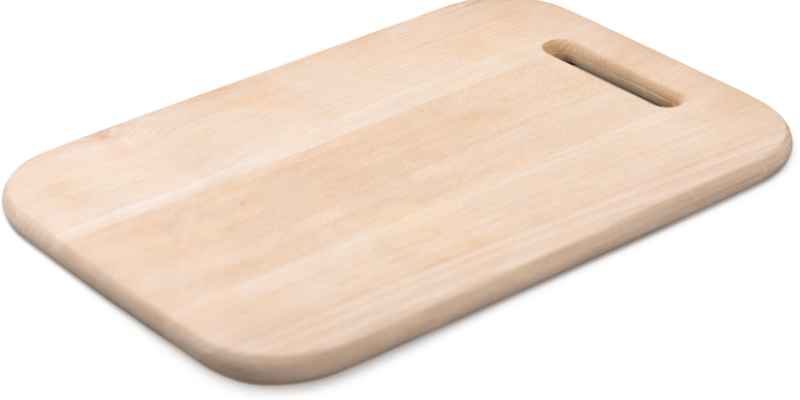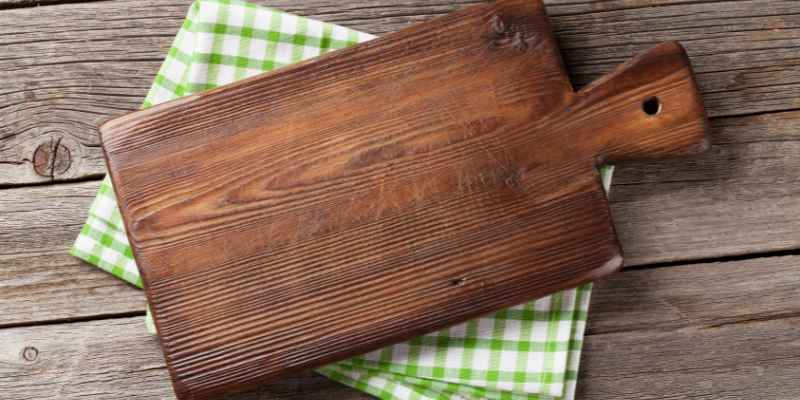No, you should not use mahogany for a cutting board due to its open grain which can trap food particles and harbor bacteria. This makes it less than ideal for kitchen use.
While mahogany is known for its durability and ability to maintain knife edges, its porous surface increases the risk of food contamination. It is important to choose the right type of wood when it comes to cutting board because using the wrong one can cause damage to knives and pose a health risk.
We will discuss the best type of wood to use for cutting boards and why mahogany is not recommended, as well as how to clean and maintain wooden cutting boards for optimal use.
Suitability Of Mahogany For Cutting Board
Mahogany’s open-grained texture doesn’t make it the best choice for a regular kitchen cutting board as it can trap food particles and harbor bacteria. Other types of wood such as acacia, maple, teak, and walnut are better suited due to their denser and less porous surface.
Cutting boards are an essential tool in any kitchen, and there are a variety of wood types available to choose from. Mahogany is a beautiful, richly-colored hardwood that has a reputation for being a durable and long-lasting wood. However, not all woods are suitable for cutting boards, and the questions of whether you can use mahogany for a cutting board arises. In this post, we will discuss the suitability of mahogany for cutting boards and compare it with other woods that can be used in cutting boards.
The role of porosity in selecting the wood for cutting board
The porosity of the wood plays a significant role in determining its suitability for cutting boards. In general, hardwoods are more suitable for cutting boards, compared to softwoods, as they are denser and more durable. But when it comes to porosity, hardwoods vary, with some being less porous compared to others. A less porous wood tends to harbor fewer bacteria, hence being more suitable for use in cutting boards.
Why Mahogany is not an ideal wood for cutting board
Despite being a dense hardwood, mahogany is not an ideal wood for cutting boards. Firstly, it is an open-grained wood, which means it can trap food particles and harbor bacteria making it less than ideal for regular kitchen use. Secondly, it has a high concentration of tannins in its wood, making it unsuitable for cutting acidic food, leading to a bitter aftertaste. Lastly, it has a high risk of splintering and cracking, which makes it less durable compared to other hardwoods.
Comparison with other woods that can be used in cutting boards
There are numerous wood types that are suited for cutting boards, including Acacia, Maple, Teak, Walnut Tree, Beech, and Bamboo. Acacia is slightly softer than other hardwoods, and it has a unique, swirled grain pattern that gives it a sophisticated look.
On the other hand, Maple is a dense, closed-grain hardwood that is tough and durable, ideal for cutting boards. Teak is another option that is popular for its beautiful golden color and resistance to moisture. It does not require an oil or sealant to maintain its luster. Walnut is an excellent choice for its rich color and soft texture, which makes it easy on knives, ensuring they remain sharp over time.
In conclusion, while Mahogany is an appealing hardwood, it is not the best choice for cutting boards due to its porosity, the level of tannins present in the wood, and its susceptibility to splinter and cracking. There are various hardwood options available that are well-suited for cutting boards, making sure it is an excellent addition to any kitchen.
Benefits Of Mahogany For Cutting Boards
Mahogany is a beautiful and durable wood that has been used for centuries in fine furniture, boat-building, and decorative finishes. But can you use mahogany for a cutting board? The answer is yes, but with some caveats. Here are some of the benefits of using mahogany for cutting boards:
Durability
Regarding cutting boards, Mahogany’s durability is a standout feature. The wood is firm enough to withstand the wear and tear of kitchen use, ensuring that your cutting board will last for years to come. Mahogany is also a dense hardwood that resists scratches and dents, making it an excellent choice for a surface that sees plenty of use.
Knife-friendliness
An essential element of a good cutting board is that it should not dull your knives. Mahogany is a relatively soft wood, which means that the edge of your blade will not be compromised when chopping and cutting. Unlike some dense hardwoods, which can be tough on knife sharpness, mahogany will help maintain the sharpness of your blades over time.
Safety And Hygiene
The porosity of wood plays a significant role in determining its suitability for cutting boards. As an open-grained wood, mahogany can trap food particles and harbor bacteria, making it less than ideal for regular kitchen use.
However, with proper care and maintenance, a mahogany cutting board can remain a safe and hygienic surface. To keep your mahogany cutting board clean, avoid soaking it in water and instead wash it with soap and warm water after each use. Dry it thoroughly and occasionally rub it with food-grade oil to help protect the wood and keep it looking beautiful.
Overall, mahogany is a robust and attractive choice for a cutting board. Its durable nature, knife-friendliness, and update look make it an excellent addition to any kitchen. Just be sure to keep up with the necessary maintenance to ensure that your cutting board remains sanitary and in good condition.
Other Woods Used In Cutting Boards

Mahogany is not recommended for cutting boards due to its open-grained texture. This texture can trap food particles and bacteria, making it less ideal for regular kitchen use. Other woods such as maple, cherry, and walnut are better choices for cutting boards.
When it comes to choosing the right wood for a cutting board, mahogany may not be the best choice due to its open-porous nature. However, there are plenty of other woods that can serve the purpose. Here are some popular woods used in cutting boards:
Acacia
Acacia is a durable wood that can handle heavy use in the kitchen. It has a tight grain and natural oils that make it resistant to water and bacteria. Acacia cutting boards are also known for their unique and beautiful patterns.
Maple
Maple is a classic choice for cutting boards due to its hardness and durability. It has a closed-grain structure that makes it highly resistant to moisture and stains. Maple is also easy to clean, making it a popular choice for professional chefs and home cooks alike.
Teak
Teak is a tropical hardwood that is naturally resistant to moisture and bacteria. It has a high oil content and tight grain structure, making it perfect for cutting boards. Teak also has a unique golden-brown color that adds warmth to any kitchen.
Walnut Tree
Walnut is a beautiful and sturdy wood that is often used in high-end cutting boards. It has a rich and dark color, and its natural oils make it resistant to water and bacteria. Walnut is also known for its hardness, which means it can withstand heavy use without dulling knives.
Beech
Beech is a European hardwood that is popular in cutting boards due to its strength and durability. It has a light color and tight grain, which make it easy to clean and resistant to stains. Beech cutting boards are also less expensive than some other hardwoods, making them a good choice for budget-conscious buyers.
Bamboo
Bamboo is a grass that is known for its sustainability and renewability. It is also a popular material for cutting boards due to its hardness and strength. Bamboo cutting boards are lightweight and easy to maintain, making them a great choice for everyday use.
Ziruma
Ziruma is a tropical hardwood that is known for its durability and resistance to water and bacteria. It has a tight grain structure that makes it easy to clean, and its natural oils make it resistant to stains. Ziruma cutting boards are also highly resistant to scratches and dents, making them a great investment for any kitchen.
Ipe
Ipe is a dense and sturdy Brazilian hardwood that is perfect for cutting boards. It has a tight grain structure and natural oils that make it naturally resistant to bacteria and water. Ipe cutting boards are also highly durable and can last for decades with proper care.
In conclusion, when choosing a wood for a cutting board, it’s important to consider its hardness, porosity, and natural resistance to water and bacteria. With so many options available, finding the right wood for your cutting board needs should be easy.
How To Clean A Mahogany Cutting Board
Mahogany may not be the best option for a cutting board due to its open grain that can trap food particles and harbor bacteria. However, if you do use mahogany, make sure to clean it properly with a mixture of vinegar and water and avoid soaking it in water.
Cleaning a mahogany cutting board is essential for maintaining a hygienic kitchen. While mahogany is a durable and safe wood for cutting boards, proper cleaning helps prevent the spread of bacteria that can lead to contamination. Here are step-by-step instructions on how to clean a mahogany cutting board.
Step-by-step instructions to clean a mahogany cutting board:
1. Wipe the board with a damp cloth to remove any loose food particles. Avoid using soap at this stage, as soap can penetrate the wood pores and leave behind a residue.
2. Create a cleaning solution by mixing equal parts water and white vinegar in a spray bottle.
3. Spray the solution over the cutting board surface and let it sit for a few minutes to disinfect the wood.
4. Use a stiff-bristled brush or sponge to scrub the board in the direction of the wood grain.
5. Rinse the board with warm water, making sure to remove all the vinegar solution.
6. Dry the board with a clean cloth and place it upright to air dry completely.
Things to avoid while cleaning the cutting board:
1. Do not soak the board in water, as this can cause the wood to warp and crack.
2. Do not use harsh chemicals or bleach to clean the board, as they can damage the wood surface and leave behind toxic residue.
3. Do not put the board in the dishwasher, as high heat and water pressure can cause the wood to split and lose its natural oils.
By following these cleaning instructions and avoiding harmful cleaning methods, you can keep your mahogany cutting board clean, hygienic, and in good condition for years to come.
Using Mahogany For End Grain Cutting Board
Mahogany may not be the best option for a cutting board due to its open-grain nature, which can trap food particles and harbor bacteria. Woods like maple, teak, and walnut are better choices for their hardness, durability, and less porous surfaces.
End grain cutting boards are known for their durability and resistance to knife marks. However, not all wood types are suitable for end grain cutting boards. In this section, we will discuss the possibility of using mahogany as an alternative for end grain cutting board.
Why End Grain is Not Suitable for Cutting Board
Before diving into the possibility of using mahogany for end grain cutting boards, let’s briefly discuss why end grain may not be suitable for a cutting board. End grain cutting boards have fibres facing upwards which gives the board an excellent ability to withstand knife marks. However, it is also highly porous, making it susceptible to bacterial growth if not appropriately cleaned and maintained.
Mahogany as an Alternative for End Grain Cutting Board
Now, let’s discuss the possibility of using mahogany as an alternative for end grain cutting boards. Mahogany is a hardwood variety that is known for its durability and strength. It has a tight grain pattern that makes it resistant to knife marks. Moreover, its tight grain pattern also means it is less porous than many other woods, making it an excellent choice for cutting boards.
Experience and Opinions of People Who Have Used Mahogany for Cutting Board
Several people have used mahogany to make their cutting boards, and the general consensus is that it is a suitable wood for making cutting boards. It is a sturdy wood, and knife marks are less likely to appear on the board’s surface. Moreover, it is also gentle on knife edges, maintaining their sharpness over time. However, as with all cutting boards, it is crucial to clean and maintain it appropriately to avoid bacterial growth.
In conclusion, mahogany is a suitable alternative for end grain cutting boards due to its durability, strength, and low porosity. Many people have used mahogany to make their cutting boards with positive results, making it a great option for those looking to make a sturdy cutting board that will withstand daily use.

Frequently Asked Questions Of Can You Use Mahogany For A Cutting Board
Is Mahogany Safe For Cutting Board?
Mahogany is not ideal for cutting boards due to its open-grained and porous nature, which can trap food particles and harbor bacteria. It is better to choose woods like acacia, maple, teak, walnut, beech, or bamboo, which have less porous surfaces and are better for regular kitchen use.
What Wood Is Not Good For Cutting Boards?
Butternut, cedar, poplar, and ash with open grain are not good for cutting boards. Mahogany, despite its durability, is not suitable for regular kitchen use due to its open-grained nature, which can trap food particles and harbor bacteria. It is best to choose woods based on their characteristics.
What Wood Is Best For A Cutting Board?
While mahogany is durable, it’s not the best wood for a cutting board. The wood is open-grained, which can trap food particles and bacteria. The best woods for cutting boards include acacia, maple, teak, and walnut tree. Avoid using soft woods like butternut, cedar, and poplar for cutting boards.
Regular cleaning of wood cutting boards is also essential to maintain their hygiene.
How Do You Clean A Mahogany Cutting Board?
Due to the open grain of mahogany, it can trap food particles and harbor bacteria, making it less than ideal for regular kitchen use. However, if you decide to use a mahogany cutting board, the best way to clean it is by using hot soapy water, a scrub brush, and then drying it carefully.
Apply mineral oil to keep the board moisturized.
Conclusion
Mahogany may not be the ideal choice for a cutting board due to its open-grained nature. The risk of harboring bacteria and trapping food particles is a concern that should not be ignored. While it may be durable and gentle on knife edges, it’s important to consider the porosity of the wood before deciding on your cutting board material.
Consider other options like acacia, maple, teak, walnut, beech, bamboo, or cherry for a safer and more hygienic cutting board.


